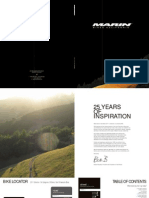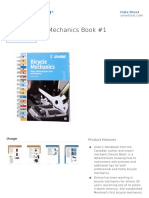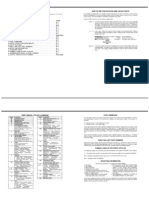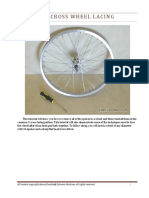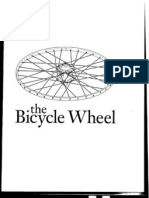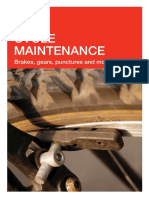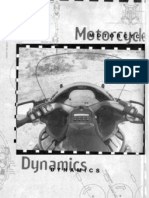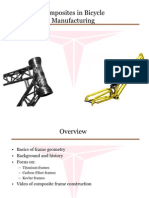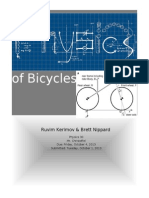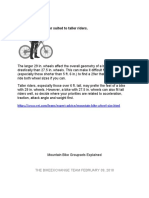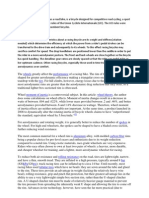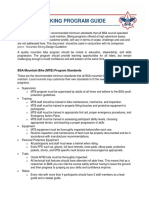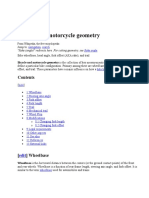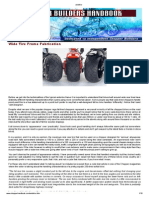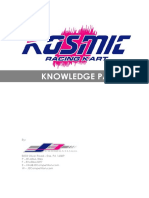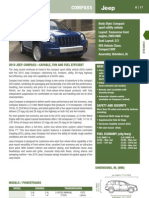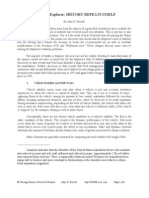Understanding Bicycle Frame Geometry - CyclingAbout CyclingAbout
Understanding Bicycle Frame Geometry - CyclingAbout CyclingAbout
Uploaded by
Ganesh NandgaonkarCopyright:
Available Formats
Understanding Bicycle Frame Geometry - CyclingAbout CyclingAbout
Understanding Bicycle Frame Geometry - CyclingAbout CyclingAbout
Uploaded by
Ganesh NandgaonkarOriginal Description:
Copyright
Available Formats
Share this document
Did you find this document useful?
Is this content inappropriate?
Copyright:
Available Formats
Understanding Bicycle Frame Geometry - CyclingAbout CyclingAbout
Understanding Bicycle Frame Geometry - CyclingAbout CyclingAbout
Uploaded by
Ganesh NandgaonkarCopyright:
Available Formats
03/10/2016
UnderstandingBicycleFrameGeometryCyclingAboutCyclingAbout
(http://www.cyclingabout.com/)
Understanding Bicycle Frame Geometry
OCTOBER 4TH, 2013
I receive a lot of questions about frame geometry, so Ive thrown together this resource todiscuss the reasons
why bike frames are built to thelengths and anglesthat they are.
This information will help you understand how a bike may ride without testing it, which isespecially handy
ifyoud like a customframe built up. Itshould alsogive you an ideaof what styleof geometry is best suited for
you.
(http://www.cyclingabout.com/wp-content/uploads/2013/10/wpid-Photo-3-Oct-2013-1141-pm.jpg)
It is important to note that bicycle geometry is always different for each size bike, given our body proportions
change with our height.
If youd like to be carrying front pannier bags,frame geometry is especially importantassteering is often
optimised around front loads.
I have incorporated a geometry comparison to road and cyclocross bikes. As frame size affects geometry, all
comparisons are for bicycles with a horizontal 57cm top tube.
Understanding the Steering
The front end of the bike is a bit complicated but Ill do my best to explain it.
http://www.cyclingabout.com/understandingbicycleframegeometry/
1/17
03/10/2016
UnderstandingBicycleFrameGeometryCyclingAboutCyclingAbout
There are three measurements at play:
Head Tube Angle
Fork Trail, and
Fork Rake (or Offset)
Out of the three, fork trail arguably tells usthe most abouthow abicycle will steer.
Head Tube Angle
(http://www.cyclingabout.com/wp-content/uploads/2013/10/wpid-Photo-4-Oct-2013-1208-am.jpg)
The headtube angle is the angle at which the head tube is to the ground.
A steeper head angled bike has faster steering. There is less effort required to steer it.
A slacker head angled bike has slower steering. There is more effort required to steer it.
Touring bikes are slacker in head angle compared to their road/cx relatives because they carry weight, and a
slower steering speed helps with the bikes stability.
Head Tube Angle Comparison for 57cm Bikes: Touring bikes 71-72 degrees. Road bikes 73-74 degrees. CX 72-73
degrees.
Fork Rake (Offset)
http://www.cyclingabout.com/understandingbicycleframegeometry/
2/17
03/10/2016
UnderstandingBicycleFrameGeometryCyclingAboutCyclingAbout
(http://www.cyclingabout.com/wp-content/uploads/2013/10/wpid-Photo-4-Oct-2013-1254-am.jpg)
Fork rake is the offset of the fork dropout center from the straight line of the steering axis (centerline of the
forks steerer tube).
Increasing the fork rake makes steering faster.
Decreasing the fork rake makes steering slower.
Touring bikes have more rake than road and cyclocross bikes to increase the their wheelbase length, provide
more toe clearance and to increase the forks comfort.
But hang on touring bikes have more rake compared to road/cx bikes yet they steer slower. Why? Well, fork
rake is only one ingredient to the steering equation. Read about trail below to understand the rest.
Fork Rake Comparison for 57cm Bikes: Touring forks 45-52mm. Road bikes 40-45mm. CX 45mm.
Fork Trail
http://www.cyclingabout.com/understandingbicycleframegeometry/
3/17
03/10/2016
UnderstandingBicycleFrameGeometryCyclingAboutCyclingAbout
(http://www.cyclingabout.com/wp-content/uploads/2013/10/wpid-Photo-4-Oct-2013-1246-am.jpg)
The product of the head tube angle and the fork rake is the trail. This is the measurement that will give us the
best indication ofhow fast a bike will steer. This measurement is not often provided by manufacturers,
although it is arguably the most important number when it comes to the handling of the front end.
Less trail equates to faster steering. It effectively makes a bike feel more nimble, like its steered with your
hands.
More trail equates to slower steering. It provides stability at higher speeds and makes the bike feel like its
steered with your hips (leaning).
Touring bikes have lots of trail to slow steering response, keeping heavy loads stable on fast descents. On the
other hand, high trail bikesexperience more wheel op making it slightly harder to keep a straight line at low to
moderate speeds (although front panniers tend to dampen this feeling).
Trail Comparison for57cm Bikes:Touring bikes 55-70mm trail. Road bikes 50-60mm. CX 55-65mm.
Steering Summary
A touring bikes geometry is optimised so that itsstable carrying front and rear loads. This is evident through a
slacker head angle and a higher fork trail than both road and cyclocross bikes.
Road bike steeringis tuned to be fast with a low trail front end. This makes sense in a racing situation where
you may need to change direction in a split second. A cyclocross bikes geometry almost always falls
somewhere in the middle between touring and road bikes.
Chainstay Length
http://www.cyclingabout.com/understandingbicycleframegeometry/
4/17
03/10/2016
UnderstandingBicycleFrameGeometryCyclingAboutCyclingAbout
(http://www.cyclingabout.com/wp-content/uploads/2013/10/wpid-Photo-4-Oct-2013-1226-am.jpg)
One of the more important measurementson a touring bike is the chainstay length. A longer chainstay length is
desirable to increase the wheelbase (making the bike more stable) and to provide ample heel clearance from
the panniers. Heel clearance is especially important for riders with large feet. Without longchainstays my size
US 12 feet will clipmy panniers.
Chainstay Length Comparison for57cm Bikes:Touring bike 445-470mm. Road bikes 405-415mm. CX 420435mm.
Wheelbase
(http://www.cyclingabout.com/wp-content/uploads/2013/10/wpid-Photo-4-Oct-2013-1253-am.jpg)
A longer wheelbase provides a more stable and comfortable ride. Touring bikes have a long wheelbase due to a
combination of a slack head angle, long fork rake and long chainstay length.
Wheelbase Comparisonfor 57cm Bikes:Touring bikes 1050-1070mm. Road bikes 996mm. CX 1018mm.
Bottom Bracket Drop
http://www.cyclingabout.com/understandingbicycleframegeometry/
5/17
03/10/2016
UnderstandingBicycleFrameGeometryCyclingAboutCyclingAbout
Bottom Bracket Drop
(http://www.cyclingabout.com/wp-content/uploads/2013/10/wpid-Photo-4-Oct-2013-1229-am.jpg)
Bottom bracket drop determines how high your cranks sit off the ground. A lower crankset results in a lower
saddle height and therefore a lower centre of gravity.
Touring bikes can need pedal clearance over obstacles, so some manufacturers provide a high bottom bracket
(53mm drop with 700c wheels). This is generally offered with bikes designed withoff-road use in mind. Other
manufacturers provide a low bottom bracket (78mm drop with 700c wheels) to maximise the bikes stability,
albeit at the risk of pedal strike. This is more common with road-oriented touring bikes.
Seat Tube Angle
(http://www.cyclingabout.com/wp-content/uploads/2013/10/wpid-Photo-4-Oct-2013-1227-am.jpg)
http://www.cyclingabout.com/understandingbicycleframegeometry/
6/17
03/10/2016
UnderstandingBicycleFrameGeometryCyclingAboutCyclingAbout
Seat tube angles dont differ a lot between touring bikes and road/cx bikes of the same size,asoptimal
pedalling positions arent all that different betweenbikes. The seat tube angle varies most between frame
sizes.
Seat Tube Angle Comparison for 57cm Bikes:Touring bikes 71-73 degrees. Road bikes 73 degrees. CX 73
degrees.
(http://www.cyclingabout.com/wp-content/uploads/2013/10/wpid-Photo-4-Oct-2013-908-am.jpg)
A very general bicycle tting rule (to optimise pedalling efciency) is to have your knee reach the pedal axle
(see diagram). If you were toslacken a seat tube angle, your knee maynot reach as far as the pedal axle (and
would therefore be less efcient, cause knee pain etc). See my resource Understanding Bike Fit
(http://www.cyclingabout.com/understanding-bike-t/) for more information on optimising your position.
Stack and Reach: Important for Comparing Bikes
(http://www.cyclingabout.com/wp-content/uploads/2014/03/wpid-Photo-20140311093038.jpg)
http://www.cyclingabout.com/understandingbicycleframegeometry/
7/17
03/10/2016
UnderstandingBicycleFrameGeometryCyclingAboutCyclingAbout
Stack and reach measurements are perhaps the best common information we have to know if a bike will t us
(http://www.cyclingabout.com/understanding-bike-t/), without testing it rst. Stack and reach measurements
assess the position of the headtube in relation to the bottom bracket, essentially standardising bike
geometry/sizing between brands and models. This is important because bikes from two manufacturers that
are both called the same size (medium or 54cm, for example) can actually t up to 2cm (a full size) different
from one another! If the companies youre looking at dont have stack and reach measurements, here is a
calculator (http://bikegeo.muha.cc/).
You can get a professional bicycle tter to determine your appropriate stack and reach, making it much easier
to nd your next perfectly tting bike. If youre interested, check outmy experience of getting a Precision Fit
(http://www.cyclingabout.com/understanding-bike-t/).
Effective Top Tube Length
(http://www.cyclingabout.com/wp-content/uploads/2013/10/wpid-Photo-4-Oct-2013-1209-am.jpg)
The effective top tube (ETT) length is the simplest way to determine a bikes size. That said,just because the
ETT is the same between the two bikes, doesnt mean the bikes will have the same reach. The ETT still tends to
bea goodguide for how far youll reach from your saddle to handlebar.
Seat Tube Length
http://www.cyclingabout.com/understandingbicycleframegeometry/
8/17
03/10/2016
UnderstandingBicycleFrameGeometryCyclingAboutCyclingAbout
(http://www.cyclingabout.com/wp-content/uploads/2013/10/wpid-Photo-4-Oct-2013-1211-am.jpg)
Seat tube length isnt too important for most people with the exception for ifyouneed the additional stand over
clearance (often smaller riders). Again, its best tocompare bikes based on their stack and reach if you can.
Head Tube Length
(http://www.cyclingabout.com/wp-content/uploads/2013/10/wpid-Photo-4-Oct-2013-1210-am.jpg)
Long head tubes are common on touring bikes in order to prop the bars up high without the use of excessive
headset spacers. Head tubes are often 40mm or more longer than the equivalent road or cyclocross bike.
Not Using a Front Pannier Rack?
If you are planning on cycle touring with front orrear bags only, frame geometry is arguably lessimportant. A
mountain bike with rear panniers will not ride all that different to a touring bike with rear panniers.
http://www.cyclingabout.com/understandingbicycleframegeometry/
9/17
03/10/2016
UnderstandingBicycleFrameGeometryCyclingAboutCyclingAbout
Touring-specic frames work out to bemore important when you use heavy gear front and rear, requiring a
super stiff front triangle and more fork trail to make your bike handle well.
Summary
A touring bikes geometry is specic to carrying loads. If you havent ridden a touring bike with lled front and
rear panniers, youre missing out. The steering and wheelbase are optimised for stability, there is ample heel
clearance and the front end is appropriately tall. Dont compromise next time, try one out for your next
adventure.
TAGS
FRAME BUILDING (HTTP://WWW.CYCLINGABOUT.COM/TAG/FRAME-BUILDING/)
FRAME GEOMETRY (HTTP://WWW.CYCLINGABOUT.COM/TAG/FRAME-GEOMETRY/)
FRAME SIZE (HTTP://WWW.CYCLINGABOUT.COM/TAG/FRAME-SIZE/)
GEOMETRY (HTTP://WWW.CYCLINGABOUT.COM/TAG/GEOMETRY/)
(http://www.facebook.com/sharer.php?u=http%3A%2F%2Fwww.cyclingabout.com%2Funderstandingbicycle-frame-geometry%2F)
(https://twitter.com/intent/tweet?text=Understanding Bicycle Frame
Geometry&url=http%3A%2F%2Fwww.cyclingabout.com%2Funderstanding-bicycle-frame-geometry%2F)
(http://plus.google.com/share?url=http://www.cyclingabout.com/understanding-bicycle-framegeometry/)
(http://pinterest.com/pin/create/button/?url=http://www.cyclingabout.com/understanding-bicycle-frame
geometry/&media=)
(http://www.cyclingabout.com/author/admin/)
Alee (http://www.cyclingabout.com/author/admin/)
Alee LOVES bikes and travel. So much so he once sold everything he owned to ride through 30 countries to
learn a bit about himself and the world. Check out his book Bicycle Touring in One Hour to do the same:
https://cyclingabout.com/bicycle-touring-book/ (https://cyclingabout.com/bicycle-touring-book/)
RELATED POSTS
http://www.cyclingabout.com/understandingbicycleframegeometry/
10/17
03/10/2016
UnderstandingBicycleFrameGeometryCyclingAboutCyclingAbout
TANDEM BIKES
TOURING BIKES
(HTTP://WWW.CYCLINGABOUT.COM/CATEGORY/TRAVEL-
(HTTP://WWW.CYCLINGABOUT.COM/CATEGORY/TRAVEL-
BIKES/TANDEM-TOURING-BIKES/)
BIKES/TOURING-BIKES/)
(http://www.cyclingabout.com/list-of-tandembuilders-and-manufacturers-with-pricing/)
(http://www.cyclingabout.com/whats-the-differencebetween-cyclocross-and-touring-bikes/)
List of Tandem Builders and Manufacturers with Pricing
(http://www.cyclingabout.com/list-of-tandem-buildersand-manufacturers-with-pricing/)
What's the Difference Between Cyclocross and Touring
Bikes? (http://www.cyclingabout.com/whats-thedifference-between-cyclocross-and-touring-bikes/)
TOURING BIKES
(HTTP://WWW.CYCLINGABOUT.COM/CATEGORY/TRAVELBIKES/TOURING-BIKES/)
(http://www.cyclingabout.com/frame-materials-forbicycle-touring-aluminium-vs-steel-vs-titanium/)
Frame Materials for Bicycle Touring: Aluminium vs Steel
vs Titanium (http://www.cyclingabout.com/framematerials-for-bicycle-touring-aluminium-vs-steel-vstitanium/)
TOURING BIKES
TANDEM BIKES
(HTTP://WWW.CYCLINGABOUT.COM/CATEGORY/TRAVEL-
(HTTP://WWW.CYCLINGABOUT.COM/CATEGORY/TRAVEL-
BIKES/TOURING-BIKES/)
BIKES/TANDEM-TOURING-BIKES/)
(http://www.cyclingabout.com/warningmanufacturers-measure-frames-differently/)
(http://www.cyclingabout.com/a-detailed-look-intothe-custom-frame-building-process/)
Warning: Manufacturers Measure Frames Differently
(http://www.cyclingabout.com/warning-manufacturersmeasure-frames-differently/)
A Detailed Look Into The Custom Frame Building Process
(http://www.cyclingabout.com/a-detailed-look-into-thecustom-frame-building-process/)
http://www.cyclingabout.com/understandingbicycleframegeometry/
11/17
03/10/2016
UnderstandingBicycleFrameGeometryCyclingAboutCyclingAbout
jedrek
Alex, have you considered running a long, angled stem like the Amoeba riser stem instead of all the head
tubes? Theyre specially designed to run drops on MTBs. I currently tour on an LHT (pic included), but Ive
built up a 29er for off-road touring and am going to give it a go with drops and a riser stem.
Alex Denham (http://www.cyclingabout.com/)
There are many ways to get the front end higher: long steerer tubes with lots of spacers, heads up
steerer extenders and angled stems to name a few. They all work, but in our mind a long headtube
with a few spacers will always be the stiffest and most attractive option.
Raymond A. Poythress
Interesting article. Nice to see how the biking concepts have evolved
and grown into their own. The packs shown seem like a must have. Great
piece.
https://www.spinlister.com/ (https://www.spinlister.com/)
Paul Stead
Fork rake and trail sounds a bit like caster and camber.
Stevie.T
So let me try get this straight track bikes have a straighter head angle to make the steer faster, then
less rake to make them steer slower one compensating for the other? Then by putting a road fork on a
track bike, Im in fact making it steer faster once more?
Stevie.T
And why do track bikes prefer using the head tube as a determinent for steering speed? More
stable than relying on rake?
Stevie.T
And it keeps the wheelbase shorter answering my own questions here. Always worth
verifying I guess
Alee Denham (http://www.cyclingabout.com/)
1. Road fork on a track bike would speed up the steering because it decreases the
trail.
2. Its all about wheelbase on a track bike. Youve got to t in some tight gaps! Steep
HA + minimal fork offset = shorter wheelbase.
Hamimi Akmal
Nice article! question which is the most preferable to use for touring bikes, road bikes or mountain
bikes? as its really hard to nd a real touring bikes at my places.. (absolute newbie)
Alee | CyclingAbout.com (http://www.cyclingabout.com/)
You are better off using a mountain bike, partially because the geometry is closer to a touring bike,
but mostly because the parts will be much more durable.
Nick
Hi Please can you correct your use of bikes and bikes it would make this interesting article easier to
read! Many thanks. Nick
Alee | CyclingAbout.com (http://www.cyclingabout.com/)
Fair comment, Ill run over it to check for errors. Alee
Ai C I. Razo
Does this apply to mountain bikes too? Increased my fork from 100 to140 travel. Im concerned about its
effect on the geometry.
http://www.cyclingabout.com/understandingbicycleframegeometry/
12/17
03/10/2016
UnderstandingBicycleFrameGeometryCyclingAboutCyclingAbout
alliwant54
There is one denite quibble I have to voice; Tire size has no bearing on BB drop. It is solely a function of
the height of the axles and the BB, as your diagram clearly shows. Trail is very much affected by tire size,
though, since it changes the diameter of the wheel. Despite my complaint, thanks for a very welcome
presentation on frames.
Alee | CyclingAbout.com (http://www.cyclingabout.com/)
Youre correct. My statement was referring more to the bottom bracket height rather than drop.
Ill x up the wording. Cheers.
(http://cyclingabout.com)
(https://www.cyclingabout.com/bicycle-touring-book/)
RECENT
()
http://www.cyclingabout.com/understandingbicycleframegeometry/
13/17
03/10/2016
UnderstandingBicycleFrameGeometryCyclingAboutCyclingAbout
Eurobike 2016 Coverage: Bicycle Touring, Bikepacking and Adventure Gallery
(http://www.cyclingabout.com/eurobike-2016-bicycle-touring-bikepacking-adventure-gallery/)
()
Video: The Bicycle Touring Family That Travelled From Quebec To Central America
(http://www.cyclingabout.com/video-bicycle-touring-family-on-bikes/)
http://www.cyclingabout.com/understandingbicycleframegeometry/
14/17
03/10/2016
UnderstandingBicycleFrameGeometryCyclingAboutCyclingAbout
()
The 11 Best Bike Touring Destinations In The World (According To Long-Distance Travellers)
(http://www.cyclingabout.com/11-best-bike-touring-destinations-in-the-world/)
()
Bicycle Touring Infographic: The 159 Best Bike Touring Destinations In The World
(http://www.cyclingabout.com/bicycle-touring-infographic-best-bike-touring-destinations/)
http://www.cyclingabout.com/understandingbicycleframegeometry/
15/17
03/10/2016
UnderstandingBicycleFrameGeometryCyclingAboutCyclingAbout
()
The New 2017 Fuji Touring Bike
(http://www.cyclingabout.com/new-2017-fuji-touring-bike/)
http://www.cyclingabout.com/understandingbicycleframegeometry/
16/17
03/10/2016
UnderstandingBicycleFrameGeometryCyclingAboutCyclingAbout
(http://www.cyclingabout.com/bicycle-touring-book-
bundle/)
(http://cyclingabout.com)
CyclingAbout is one of the biggest bicycle travel resources in the world. It's home to the webs most detailed tech articles,
oodles of inspiration, in-depth reviews, fun videos, tips, how-tos and more.
(https://twitter.com/Cycling_About) (http://facebook.com/cyclingabout)
(https://www.youtube.com/user/CyclingAboutOfcial)
(https://vimeo.com/cyclingabout)
CyclingAbout 2016. All rights reserved.
Produced by CyclingAbout Media (http://www.cyclingabout.com)
http://www.cyclingabout.com/understandingbicycleframegeometry/
17/17
You might also like
- The Custom BicycleDocument276 pagesThe Custom BicycleMark JohanssonNo ratings yet
- Bicycle Design An Illustrated History (2014) Tony Hadland, Hans-Erhard LessingDocument583 pagesBicycle Design An Illustrated History (2014) Tony Hadland, Hans-Erhard Lessingkhushi78650% (4)
- Marin 2011Document56 pagesMarin 2011mountainbikerus75% (4)
- Kawasaki KLR 650 TimelineDocument26 pagesKawasaki KLR 650 TimelineRichard Krige100% (2)
- Prophetiarium Xicatunense 2006Document40 pagesProphetiarium Xicatunense 2006am_rivera15539No ratings yet
- Twerminal Velocity WheelbuildingDocument16 pagesTwerminal Velocity WheelbuildingJackson WallNo ratings yet
- The Bicycle WheelDocument147 pagesThe Bicycle WheelVytautas100% (8)
- FIXED Global Fixed-Gear Bike CultureDocument152 pagesFIXED Global Fixed-Gear Bike CultureLiam ProvenNo ratings yet
- Unior Bicycle Mechanics Book #1: Kat - Bikebook1Document2 pagesUnior Bicycle Mechanics Book #1: Kat - Bikebook1Putra KurniaNo ratings yet
- Potential Flow Around A Circular CylinderDocument4 pagesPotential Flow Around A Circular CylinderGanesh NandgaonkarNo ratings yet
- Driver's HandbookDocument285 pagesDriver's HandbookXuan Hu100% (5)
- Jeep Parts Catalog 81-86 CJ XJ SJDocument1,741 pagesJeep Parts Catalog 81-86 CJ XJ SJcrankyhobo83% (6)
- 3 Cross Wheel LacingDocument41 pages3 Cross Wheel Lacingbob100% (1)
- Proteus FramebuildingDocument114 pagesProteus FramebuildingMark JohanssonNo ratings yet
- Bicycle Wheel TruingDocument7 pagesBicycle Wheel TruingJesse MynerNo ratings yet
- BikeTouringBasics v2 TravellingTwoDocument66 pagesBikeTouringBasics v2 TravellingTwoNorman StreetNo ratings yet
- BikesDocument10 pagesBikesRikki Lyle ChandlerNo ratings yet
- Specialized Bicycle Owner S Manual 1Document60 pagesSpecialized Bicycle Owner S Manual 1caiodm100% (1)
- Pa TerekDocument434 pagesPa TerekNikos Gkalinas100% (2)
- A Highly Unlikely Bicycle Tourist - Stephen PeelDocument24 pagesA Highly Unlikely Bicycle Tourist - Stephen PeelStephen PeelNo ratings yet
- Bicycle WheelDocument147 pagesBicycle WheelFoolvision100% (7)
- Wheel Building 101Document3 pagesWheel Building 101Lopez GardoNo ratings yet
- Specialized 2017 CatalogDocument336 pagesSpecialized 2017 CatalogGeorge DumitrescuNo ratings yet
- Bicycle Frame BuildingDocument45 pagesBicycle Frame BuildingRam ShewaleNo ratings yet
- Bicycle Touring ProDocument160 pagesBicycle Touring Prowacbrat100% (4)
- Cycle Maintenance: Brakes, Gears, Punctures and MoreDocument16 pagesCycle Maintenance: Brakes, Gears, Punctures and Moreprem543210% (1)
- RockShox Suspension Setup and Tuning GuideDocument50 pagesRockShox Suspension Setup and Tuning GuideNicky KiloNo ratings yet
- Bicycle - An Engineering MarvelDocument55 pagesBicycle - An Engineering Marvelb1657937No ratings yet
- Bicycle FreewheelDocument13 pagesBicycle Freewheeltransinov100% (1)
- Bicycle Structure DynamicsDocument7 pagesBicycle Structure Dynamicsso_farNo ratings yet
- The Bicycle WheelDocument147 pagesThe Bicycle WheelmladenpitesaNo ratings yet
- Rockshox Suspension Theory 10-ReplicaDocument28 pagesRockshox Suspension Theory 10-Replicaxpert_vtNo ratings yet
- BSA Bicycle TouringDocument18 pagesBSA Bicycle Touringtspinner19No ratings yet
- Lacing WheelsDocument10 pagesLacing WheelsUmberto NicolisNo ratings yet
- Proficient Motorcycling Chapter2Document23 pagesProficient Motorcycling Chapter2Dana Vede100% (1)
- LB User-Manual-WheelDocument19 pagesLB User-Manual-WheelDeac BogdanNo ratings yet
- Composites in Bicycle ManufacturingDocument14 pagesComposites in Bicycle ManufacturingdreadshawnNo ratings yet
- Mountain BikeDocument170 pagesMountain BikeStoleri George100% (2)
- FOX Shox 2009EnglishOMDocument322 pagesFOX Shox 2009EnglishOMmykeenzo5658100% (1)
- Bicycle Wheelbuilding The Manual1Document69 pagesBicycle Wheelbuilding The Manual1jcb1961100% (1)
- New Version Physics of BikesDocument6 pagesNew Version Physics of Bikesapi-239483431No ratings yet
- Bicycle Gearing - Wikipedia, The Free Encyclopedia PDFDocument14 pagesBicycle Gearing - Wikipedia, The Free Encyclopedia PDFfrontex2007No ratings yet
- Bicycle Gearing - WikipediaDocument65 pagesBicycle Gearing - WikipediaanilbabuNo ratings yet
- Road Bikes Vs MTBDocument6 pagesRoad Bikes Vs MTBMoiz SetharNo ratings yet
- Fit 29ers Are Often Better Suited To Taller Riders.: The Bikeexchange Team February 09, 2018Document8 pagesFit 29ers Are Often Better Suited To Taller Riders.: The Bikeexchange Team February 09, 2018bveNo ratings yet
- MTB 3Document8 pagesMTB 3bveNo ratings yet
- Pedal Car Construction: Chassis DesignDocument4 pagesPedal Car Construction: Chassis DesignanilbabuNo ratings yet
- All Terrain Vehicle Project SynopsisDocument14 pagesAll Terrain Vehicle Project SynopsisTARUN DHUNNA100% (5)
- A Racing BicycleDocument4 pagesA Racing BicycleEncik LeepanNo ratings yet
- Screenshot 2023-06-27 at 16.54.26Document1 pageScreenshot 2023-06-27 at 16.54.26Alexandru MoldovanNo ratings yet
- Technical Evaluation GeometryDocument11 pagesTechnical Evaluation Geometry-74yl0rm4de-No ratings yet
- Mountain Biking Program GuideDocument12 pagesMountain Biking Program GuideBillNo ratings yet
- Bicycle and Motorcycle Geometry, TrailDocument7 pagesBicycle and Motorcycle Geometry, TrailAnup Kumar TanejaNo ratings yet
- Como Construir Uma Mini ChopperDocument25 pagesComo Construir Uma Mini Chopperjefersonjaj100% (2)
- Manual Wheelchairs PDFDocument44 pagesManual Wheelchairs PDFrisoviNo ratings yet
- The Basic Parts of A Mountain BikeDocument33 pagesThe Basic Parts of A Mountain BikebveNo ratings yet
- The Basic Parts of A Mountain BikeDocument33 pagesThe Basic Parts of A Mountain BikebveNo ratings yet
- The Basic Parts of A Mountain BikeDocument33 pagesThe Basic Parts of A Mountain BikebveNo ratings yet
- The Basic Parts of A Mountain BikeDocument33 pagesThe Basic Parts of A Mountain BikeBannie EslavaNo ratings yet
- Widetire Frame FabDocument10 pagesWidetire Frame FabRiki Mandol100% (1)
- Kosmic Knowledge PKT V2Document17 pagesKosmic Knowledge PKT V2DNo ratings yet
- A Quick Guide To Motorcycle RakeDocument11 pagesA Quick Guide To Motorcycle Rakesatria hiuNo ratings yet
- Specialized Manual 2015Document8 pagesSpecialized Manual 2015AndresGarrudoNo ratings yet
- All About Bicycles - A GuideDocument9 pagesAll About Bicycles - A GuidevichuvishnurockzzzNo ratings yet
- Thermal Barrier Coatings: Seminar Mid Report OnDocument6 pagesThermal Barrier Coatings: Seminar Mid Report OnGanesh NandgaonkarNo ratings yet
- Biosensors Unit 1Document30 pagesBiosensors Unit 1Ganesh Nandgaonkar100% (1)
- P242 Basic Electronics LabDocument61 pagesP242 Basic Electronics LabGanesh NandgaonkarNo ratings yet
- EG Lab DatasheetDocument27 pagesEG Lab DatasheetGanesh NandgaonkarNo ratings yet
- Pumps - Nptel Iit KanpurDocument20 pagesPumps - Nptel Iit KanpurGanesh NandgaonkarNo ratings yet
- ITSyllabusVersion2 0Document152 pagesITSyllabusVersion2 0Ganesh NandgaonkarNo ratings yet
- Automobilies & Auto Ancillaries Setor PresentationDocument63 pagesAutomobilies & Auto Ancillaries Setor PresentationVarun BaxiNo ratings yet
- Yamaha FILE CERTDocument105 pagesYamaha FILE CERTDEEPAKNo ratings yet
- Automotive Resource Guide PDFDocument233 pagesAutomotive Resource Guide PDFAndrei ItemNo ratings yet
- Daftar Nilai Mulok SDN7 LuwukDocument22 pagesDaftar Nilai Mulok SDN7 Luwukbasir.glp25No ratings yet
- 2010 Jeep Compass InformationDocument2 pages2010 Jeep Compass InformationswiftNo ratings yet
- September 2017: Road Test of Honda's Gold WingDocument17 pagesSeptember 2017: Road Test of Honda's Gold WingDanno NNo ratings yet
- Perspectives On Strategy The Real Story Behind Honda's SuccessDocument18 pagesPerspectives On Strategy The Real Story Behind Honda's SuccessRahul R SNo ratings yet
- Why WPCDocument2 pagesWhy WPCMikel IparragirreNo ratings yet
- Specialized Turbo Levo Uomo MY18Document8 pagesSpecialized Turbo Levo Uomo MY18Simone LanciottiNo ratings yet
- El Paso Scene October 2013Document60 pagesEl Paso Scene October 2013Anonymous gMmJrV1pfNo ratings yet
- Ford Explorer History Repeats Itself, by John D RowellDocument6 pagesFord Explorer History Repeats Itself, by John D RowellCDRB100% (2)
- Ujian Mac English Year 3 Paper 1Document10 pagesUjian Mac English Year 3 Paper 1nurinsyirah1402_9254No ratings yet
- Volkswagen Jetta ANCAP PDFDocument2 pagesVolkswagen Jetta ANCAP PDFcarbasemyNo ratings yet
- Royal EnfieldDocument24 pagesRoyal EnfieldAbhimanue Carefully Careless100% (1)
- BMW Pricelist PDFDocument1 pageBMW Pricelist PDFSatria Arthaf WiradinataNo ratings yet
- OpTransactionHistory30 06 2019 PDFDocument12 pagesOpTransactionHistory30 06 2019 PDFMental MentalNo ratings yet
- Informatika 7 - Sas Kelas Vii Informatika - 1670828084573Document107 pagesInformatika 7 - Sas Kelas Vii Informatika - 1670828084573GLEDYSAPRICILIANo ratings yet
- SuzukiDocument38 pagesSuzukiharsingh35100% (4)
- Sprint Car Racing: Non-Winged Sprint CarsDocument5 pagesSprint Car Racing: Non-Winged Sprint CarsNeville DickensNo ratings yet
- 2009 Night Rod SpecialDocument17 pages2009 Night Rod SpecialLibertyNo ratings yet
- 2018 Fiat 500X Features and OptionsDocument8 pages2018 Fiat 500X Features and OptionsFiat500USANo ratings yet
- Drive ShaftDocument8 pagesDrive ShaftAkshat SharmaNo ratings yet
- Prueba de Nivelacion InglésDocument11 pagesPrueba de Nivelacion InglésgdiazbandresNo ratings yet
- Formula DriftDocument23 pagesFormula DriftHudson George ThomasNo ratings yet
- Yahama's Macro and Micro Marketing EnvironmentDocument5 pagesYahama's Macro and Micro Marketing EnvironmentBenny Dsouza100% (1)


